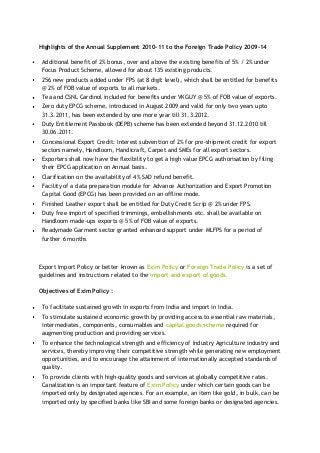
Highlights of the annual supplement 2010
- 1. Highlights of the Annual Supplement 2010-11 to the Foreign Trade Policy 2009-14 Additional benefit of 2% bonus, over and above the existing benefits of 5% / 2% under Focus Product Scheme, allowed for about 135 existing products. 256 new products added under FPS (at 8 digit level), which shall be entitled for benefits @ 2% of FOB value of exports to all markets. Tea and CSNL Cardinol included for benefits under VKGUY @ 5% of FOB value of exports. Zero duty EPCG scheme, introduced in August 2009 and valid for only two years upto 31.3.2011, has been extended by one more year till 31.3.2012. Duty Entitlement Passbook (DEPB) scheme has been extended beyond 31.12.2010 till 30.06.2011. Concessional Export Credit: Interest subvention of 2% for pre-shipment credit for export sectors namely, Handloom, Handicraft, Carpet and SMEs for all export sectors. Exporters shall now have the flexibility to get a high value EPCG authorisation by filing their EPCG application on Annual basis. Clarification on the availability of 4% SAD refund benefit. Facility of a data preparation module for Advance Authorization and Export Promotion Capital Good (EPCG) has been provided on an offline mode. Finished Leather export shall be entitled for Duty Credit Scrip @ 2% under FPS. Duty free import of specified trimmings, embellishments etc. shall be available on Handloom made-ups exports @ 5% of FOB value of exports. Readymade Garment sector granted enhanced support under MLFPS for a period of further 6 months Export Import Policy or better known as Exim Policy or Foreign Trade Policy is a set of guidelines and instructions related to the import and export of goods. Objectives of Exim Policy : To facilitate sustained growth in exports from India and import in India. To stimulate sustained economic growth by providing access to essential raw materials, intermediates, components, consumables and capital goods scheme required for augmenting production and providing services. To enhance the technological strength and efficiency of Industry Agriculture industry and services, thereby improving their competitive strength while generating new employment opportunities, and to encourage the attainment of internationally accepted standards of quality. To provide clients with high-quality goods and services at globally competitive rates. Canalization is an important feature of Exim Policy under which certain goods can be imported only by designated agencies. For an example, an item like gold, in bulk, can be imported only by specified banks like SBI and some foreign banks or designated agencies.
- 2. The Government of India notifies the Exim Policy for a period of five years (1997-2002) under Section 5 of theForeign Trade (Development and Regulation Act), 1992. The current policy covers the period 2002-2007. The Export Import Policy is updated every year on the 31st of March and the modifications, improvements and new schemes became effective from 1st April of every year. All types of changes or modifications related to the Exim Policy is normally announced by the Union Minister of Commerce and Industry who co-ordinates with the Ministry of Finance, the Directorate General of Foreign Trade and its network of dgft regional offices.
